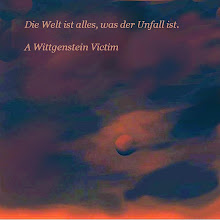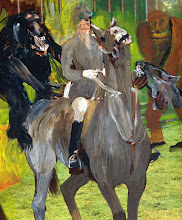Nietzsche is strangely in agreement with the Turkish Sufi dervishes of Scutari described by de Nerval in his “Voyage en Orient”. Perhaps because their doctrines are somehow Platonic (Socratic), reflecting the early rediscovery of ancient Greek philosophy by the Islamic Andalusian world (Averroes), long before Christian Europe. Nietzsche’s theories of the ‘untrue copy’; character is the bogus copy, the untrue mimesis of the Platonic idea - are particularly Andalusian. But all philosophies of human nature in its cosmic situation whose first principle is sham are in some way theatrical, Sufis included.
Nietzsche endlessly proclaims the absolute hegemony of “Schein” (appearance, illusion) and the non-existence of “Wesen” (essence). For instance: “Was ist mir jetzt “Schein”! Wahrlich nicht der Gegensatz irgend eines Wesens, — was weiss ich von irgend welchem Wesen anzusagen, als eben nur die Prädikate seines Scheines!” (“What is “appearance” for me now? Certainly not the opposite of some essence — what can I announce about any essence except the predicates of its appearance!”) (Nr 54. Das Bewusstein von Scheine. In “Die Fröhliche Wissenschaft”, München, 1988, p. 417)
De Nerval distinguishes between three kinds of Turkish dervishes: the sceptics or ‘haireti’, the material pantheists or ‘munashi’ and the spiritual dogmatists or ‘eschraki’. In particular the haireti are those who “represent the spirit of scepticism and indifference”, they are “truly Epicureans”. The ‘haireti’ are those who propose in principle that one cannot distinguish between lie and truth. “Thus it is imprudent”, writes de Nerval, “considering the subtleties of human malice to try to dispel any kind of idea.” As you can be deceived by your passion — unless your passion is falsehood too — “it can render you unjust in good as in evil”; it is best to abstain and say “Allah bilour…bizé haranouk! God knows and we do not know (…)” (from Gérard de Nerval, Voyage en Orient, Volume II, Editions Gallimard, p. 666)
One hears in Nietzsche’s exclamation “What can I announce about any essence etc” the echo of the resignation of the Sufi ‘heretic’. Although he would be less likely to approve of the munashi, whose beliefs in the transmigration of souls, led them to an early form of Darwin’s theory of evolution. Accordingly, all animals could have been humans in a previous life, and certain animals by virtue of their intelligence and fidelity are worthy of becoming human in future lives. Their monasteries (teké) were animal sanctuaries, especially for pigs, thought to most closely resemble humans in appetites and temperament. The Sufis though, because of their holiness, were allowed to eat even forbidden meat such as pork and rabbit. They were also not obliged to make the pilgrimage to Mecca. The eschraki are those whose doctrines are most obviously derived from Pythagoras and Plato – the contemplation of God in numbers, forms and colors. They were the philosopher-artists resembling Nietzsche’s own ideal condition, demonstrating once again that you can’t run away from the Orient. Wherever you run it is there to meet you.
As philosophers of sham Heidegger and Kierkegaard also borrow heavily from pre-philosophical theatrical sources. Heidegger legitimates his choice of “Sorge” or Care, as a founding category of Dasein, by deferring to Goethe’s Faust II. The mythical allegorical Sorge or Cura appears as one of the four hags invading Faust’s palace shortly before his final removal by Mephistopheles. Heidegger grafts his whole ontological edifice upon this “pre-ontological” theatrical rendition of the myth. Similarly, Kierkegaard identifies so completely with Mozart's “Don Giovanni” that he discovers in Don Juan’s erotic life the unfolding of the pure energy of Angst – “Don Juan’s life is not despair, rather the whole power of the sensual which is born in fear (Angst) and Don Juan himself is this fear, but exactly this fear is his demonic lust for life.” (Kierkegaard, “The Stages of the Immediate-Erotic or the Musical-Erotic” in Either-Or, Jena, 1911, p.118-9).
Heidegger’s predisposition to sham is reflected in those two modes of “Dasein” (Being) he calls authenticity and inauthenticity. When Dasein is “in the world” it is always inauthentic. Heidegger’s demonstrations in “Sein und Zeit” (Being and Time) are overtly and covertly driven by the attempt to prove the existence of his predicated “authentic” Dasein. His designating of “Angst” as the quasi-empirical mood in which Dasein finally is segregated with itself, if only for a moment, is first of all as Heidegger says “just a claim”. The reference to various disquisitions about Goethe’s Faust in literary journals suffices to anchor Heidegger’s second attempt to show how Dasein occurs in an “authentic” mode - as “Sorge” (Care). Inauthenticity is however the rule, authenticity is so brief and rare as to be almost non-existent.
Kierkegaard’s theatricality is far more direct and flamboyant. He appropriates the whole character of Don Giovanni for his elaborations upon the erotic and the musical. Heidegger merely borrows a detail from Goethe’s Faust to fix his ontological apparatus on to something familiar from the “pre-ontological” world – itself the inauthentic terrain of das Man. It is striking that literary scholars have frequently compared the two characters of Faust and Don Juan (including de Nerval in the preface to his translation of Faust I). Both Faust and Don Juan are considered prototypes of the doomed aristocratic rebel against the established cosmic and social orders. They are both indirectly victims of “das Man”. Besides, Don Giovanni has the added virtue from the point of view of a philosophy of sham, of being the personification of the “untrue”. Although for the Arab-Spanish world of Andalusia, the birthplace of the ‘picaro’ and the myth of Don Juan, the fleetingness of love is merely a function of the fleetingness of all things, the shadow nature of the surface. It is not that Don Giovanni is unfaithful, love is just too short. It is over long before 'finitude'. Trueness and untrueness are merely temporal categories. How can fidelity exist in an “untrue” world except as an “untrue copy”?

















.jpg)














No comments:
Post a Comment